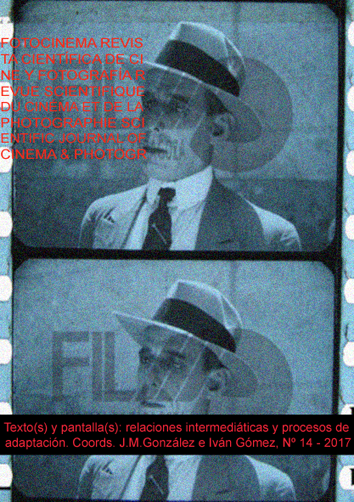La adaptación en la era intermediática: textos, pantallas e industria
DOI:
https://doi.org/10.24310/Fotocinema.2017.v0i14.3533Keywords:
cine, literatura, adaptación, intertextualidad, remake, Cinema, Literature, Adaptation, Intertextuality, RemakeAbstract
La literatura ha suministrado tramas, temas y argumentos al cine desde sus orígenes. Ya hace tiempo que desde el mundo académico se habla de un nuevo paradigma en las relaciones entre medios, pues los constantes trasvases que experimentan las historias nos obligan a entender la adaptación como un concepto amplio que no se limita a las relaciones entre literatura y cine. Vivimos en un mundo plagado de relatos y éstos se consumen de muy variadas maneras. Estas nuevas pautas de consumo han provocado a su vez que los creadores de historias sean cada día más receptivos a la posibilidad de pensar una obra como algo traducible o, cuando menos, reconducible a diferentes plataformas y soportes. El fenómeno de la adaptación es hoy más que nunca un fenómeno intermediático que debe estudiarse atendiendo a las diferentes plataformas y universos de referencia que proveen contenidos, temas y argumentos al cine, medio que, a su vez, es el origen de productos que se desarrollan en otros formatos y medios. No podemos entender correctamente la actual industria del entretenimiento sin analizar atentamente estos constantes trasvases.
Abstract:
The literature has provided master plots to cinema from its origins. For many years we spoke about a new paradigm in the relationship between media. The usual exchanges between media compel us to understand adaptation as a broad concept not limited to the relationship between literature and film. We live in a world full of stories and these are consumed in many different ways. These new consumption patterns have changed the creators´ mind who are more receptive of thinking their works as something that could travel between different platforms and media. Adaptation is now more than ever an intermedial phenomenon that must be considered on different platforms and universes of reference. The exchanges between cinema, television, literature and videogames are made on a daily basis and we can´t understand the present entertainment industry without a close reading of this factDownloads
Metrics
References
Aresté, J.M. (2006). Escritores de cine. Madrid: Espasa-Calpe.
Cascajosa, C. (2006). El espejo deformado. Versiones, secuelas y adaptaciones en Hollywood. Sevilla: Universidad de Sevilla.
Cascajosa, C. (2016). La cultura de las series. Barcelona: Laertes.
De Felipe, F.; Gómez, I. (2008). Adaptación. Barcelona: Extensiones.
Freedman, H. (2016). The time of my life. Barcelona: Blackie Books.
Gabler, N. (2015). Un imperio propio. Cómo los judíos inventaron Hollywood. Almería: Confluencias. Edición original de 1988.
Koszarski, R. (2011). El cine de los años 20. En Brunetta, G.P. Historia mundial del cine I. Estados Unidos. Madrid: Akal. Edición original de 1999.
Pardo, P.J.; Sánchez Zapatero, J. (2014) (eds.). Sobre la adaptación y más allá: trasvases filmoliterarios. Salamanca: Ediciones de la Universidad de Salamanca.
Peña-Ardid, C. (1992). Literatura y cine. Madrid: Cátedra.
Riambau, E. (2011). Hollywood en la era digital. Madrid: Cátedra.
Stam, R. (2000). Teorías del cine. Barcelona: Paidós.
Stam, R.; Raengo, A. (eds.) (2005). Literature and film: A guide of the Theory and Practice of Film Adaptation. Oxford: Blackwell.
Vanoye, F. (1996). Guiones modelo y modelos de guión. Barcelona: Paidós.
Downloads
Published
How to Cite
Issue
Section
License
All contents published in Fotocinema Revista científica de cine y fotografía are protected under the Creative Commons Attribution-NonCommercial-ShareAlike 4.0 International (CC BY-NC-SA 4.0) license. All about this license is available in the following link: <http://creativecommons.org/licenses/by-nc-sa/4.0>
Users can copy, use, redistribute, share and exhibit publicly as long as:
- The original source and authorship of the material are cited (Journal, Publisher and URL of the work).
- It is not used for comercial purposes.
- The existence of the license and its especifications are mentioned.
There are two sets of authors’ rights: moral and property rights. Moral rights are perpetual prerogatives, unrenounceable, not-transferable, unalienable, imprescriptible and inembargable. According to authors’ rights legislation, Fotocinema. Revista científica de cine y fotografía recognizes and respects authors moral rights, as well as the ownership of property rights, which will be transferred to University of Malaga in open access. The property rights are referred to the benefits that are gained by the use or the dissemination of works. Fotocinema. Revista científica de cine y fotografía is published in an open access form and it is exclusively licenced by any means for doing or authorising distribution, dissemination, reproduction, , adaptation, translation or arrangement of works.
Authors are responsable for obtaining the necessary permission to use copyrighted images.













13.png)



